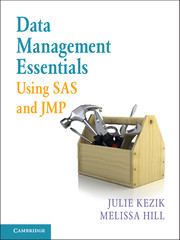Book contents
- Frontmatter
- Contents
- Acknowledgments
- About This Book
- How to Use This Book
- Chapter 1 Navigation
- Chapter 2 Preliminary Data Exploration
- Chapter 3 Storing and Manipulating Data
- Chapter 4 Advanced Concepts in Dataset and Variable Manipulation
- Chapter 5 Introduction to Common Procedures
- Chapter 6 Procedures for Simple Statistics
- Chapter 7 More about Common Procedures
- Chapter 8 Data Visualization
- Chapter 9 JMP as an Alternative
- Index
About This Book
Published online by Cambridge University Press: 05 June 2016
- Frontmatter
- Contents
- Acknowledgments
- About This Book
- How to Use This Book
- Chapter 1 Navigation
- Chapter 2 Preliminary Data Exploration
- Chapter 3 Storing and Manipulating Data
- Chapter 4 Advanced Concepts in Dataset and Variable Manipulation
- Chapter 5 Introduction to Common Procedures
- Chapter 6 Procedures for Simple Statistics
- Chapter 7 More about Common Procedures
- Chapter 8 Data Visualization
- Chapter 9 JMP as an Alternative
- Index
Summary
In research groups around the world, SAS is used not only by statisticians and investigators for data analysis but by programmers and data managers to handle seemingly endless libraries of priceless data. These data management teams often include support staff who have been selected and hired for their attention to detail and patience with meticulous tasks, but who are not necessarily fluent in SAS. The typical solution is for more advanced users to do excessive and simplistic programming to provide the output necessary for whatever task the assistant will be handling. This cycle creates extra work for advanced users and limits the independent effectiveness of the support team – a frustrating arrangement for all parties involved.
In the face of this conundrum we sought a training program for our support team. We found that no training program existed that met our specific needs; available resources were either too costly, too time consuming, or too statistically driven. Eventually we developed and initiated our own basic SAS training program for our programming and research assistants. Spending some structured time with employees while they explored SAS was the most economical way to teach basic users the skills they needed to complete daily tasks. Since training our own staff, we have experienced increased productivity by an empowered support team. This book is a result of that successful endeavour, which inspired us to share our curriculum with other groups who are undoubtedly faced with the same challenge.
SAS programming is a creative and iterative process designed to empower the user. The purpose of this text is not to instruct users on how to complete specific tasks, but to provide a toolkit of essentials for new and infrequent users. When used appropriately, this book will enable these users to explore, interpret, process, and summarize data independently.
- Type
- Chapter
- Information
- Data Management Essentials Using SAS and JMP , pp. xi - xiiPublisher: Cambridge University PressPrint publication year: 2016



